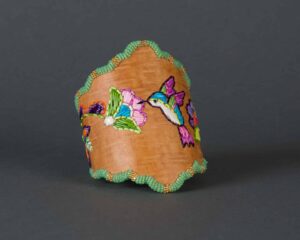Monica Raphael
Lesson: Using Natural Dyes
I use all different types of dyes for quills. I use Rit dye…I also use things like Kool-Aid, food coloring, and I also use some natural dyes. The sumac tree makes a really pretty yellow, golden yellow. There’s different berries that make really pretty purples, magenta colors…The bark of a tree, the cherry bark, you use that and that makes a rusty-brownish color. There’s all different things that I use to dye them that are historic somewhat, but also very modern too. I consider that all part of the art, actually harvesting and knowing how to make your own materials.
–Monica Raphael, Anishinaabe/Sičáŋğu Lakota
Themes: Continuation and Innovation
Learning Objective: Students will be introduced to artist Monica Raphael and her artwork. Inspired by Monica and her artwork, students will experiment with natural dyes – collecting natural materials, creating dyes and dyeing items like cloth, cotton balls, and yarn.
Background Information
The world is full of color everywhere you look, sometimes from unexpected places. Many natural dyes can be created from things you may have in and around your house. The skins of an onion that you may throw away can create reddish-brown, orange, or yellow dyes. Dandelions can create vibrant to muted yellows, or if modified with iron, olive greens to dark browns. Beets can give you anything from pink to dark red. Even red cabbage brings beautiful hues of purple and blue.
In 1856, the first synthetic dye was created by an 18-year-old chemist who was trying to find a way to create artificial quinine to treat malaria. While this discovery began a sort of chain reaction—with new colors being artificially created quickly—natural dyes have been in use for at least 5000 years. These new synthetic dyes were swiftly embraced by artists around the world because they were easy to produce, required fewer materials, took less time to make (some natural dyes require tens of thousands of specimens to produce a pound of dye), and the color possibilities were endless. In the middle of the industrial revolution, it seemed as if these new chemical dyes were the sustainable wave of the future. Whether they are or not is a far more complicated question to answer.
Today, Native American peoples use both natural and synthetic dyes in their art. Using both traditional knowledge and prepared dyes that can be found at many major retailers, they create weavings that dazzle, quillwork like Monica Raphael’s that stuns, and basketry that amazes. From dyes that have been around thousands of years to those recently discovered, a rainbow of colors that range from vibrant to muted is at every artist’s fingertips.
Image credit: Monica Raphael (Anishinaabe / Sičaŋǧu Lakota, born 1964) Anama’ewin Omaajiitoon “He / She takes our prayers”, 2021 birch bark, sweet grass, porcupine quills (natural and commercial dyes), porcupine guard hair, oak, brain tanned smoked deer hide, size 13 beads, and 24K gold Czech charlotte cut beads, thread 25 × 3 × 3 in.
Activity
Dyeing can be as simple or as complicated as you want it to be. With just a few simple supplies and time, you can make your own beautifully dyed textiles. Add crushed berries, onion skins, coffee grounds, or other natural materials to glass jars filled with distilled water. Set the sealed jars on a sunny windowsill for a few days, then strain the liquid into another container and discard the solid materials. Add some vinegar to the dye liquid, stir, put the material you want to dye in the jar, seal it up again, then place the jars back on that sunny windowsill for a few more days. After the dye has had time to saturate the material fully, remove it and hang or lay flat on paper towels to dry. This is just one of many ways to create dyes. Experiment! Have fun! Be messy!
Use the dyed items to create an art project; let your imagination run wild.
Dye Supplies: Materials to dye (paper, cloth, cotton balls), natural dye materials to experiment with (onion skin, dandelions, coffee grounds, berries), gloves, 8 or 16-oz glass jars with lids, stir sticks or plastic spoons, distilled water, vinegar
Words you need to know
Synthetic
Made from chemicals or artificial ingredients instead of natural materials.
Mordant
Something that fixes a dye to a material permanently.
Dyeing
The process of coloring something.







